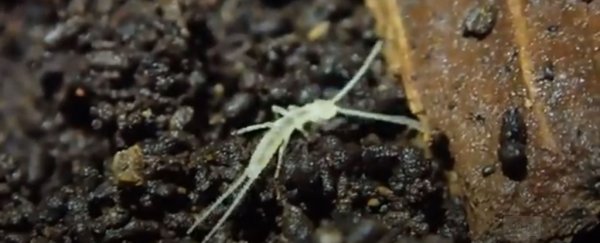You know you're a tough nut when the two options that could explain your continued existence are either having spent the last ice age in a cave buried by a sheet of ice, or having 'fast' travelled between continents in the last few tens of thousand years.
But those are the two most likely stories of the recently discovered species Haplocampa wagnelli, which was found last year in a limestone cave on Vancouver Island, Canada.
The creature itself honestly isn't much to look at – it's around 5 millimetres (0.2 inches) long, with medium sized antennas, six legs, and completely white, to the point of almost being translucent.
Although this guy looks like a little insect, it technically belongs to another group of six-legged creatures, the order diplura - they are also sometimes called 'two-pronged bristletails'.
And to the untrained eye, it might even appear like any tiny dipluran found under a random rock in the garden.
This #NewSpecies of #dipluran from the island of #Vancouver (Canada) has either spent the Last Glacial Maximum period in caves deep below a sheet of ice or has travelled transcontinentally.
— Subterranean Biology (@subtbiol) February 5, 2019
See: https://t.co/nFUEsDH8UB @Eurekalert@UAHes #Diplura #Biodiversity #Taxonomy #Zoology pic.twitter.com/YteGUEGOr2
But it's where the researchers found the creatures that's exciting - this dipluran marks one of the northernmost colonies ever found.
"This is a very intriguing species because it looks like it lived underground in caves – for more or less a long time," one of the researchers, Alberto Sendra from the University of Alcalá in Spain, said in an interview with the Canadian Press.
"This means they can survive in the glacial period. And this is very remarkable because there are no examples of species that live in subterranean areas so up north."
Most cave versions of diplurans have very long bodies and appendages, including their antennae and tails. But although H. wagnelli were also found in a cave, they only had slightly longer antennae and a thicker body.
This points to a bodily shape not entirely well adapted for a life in caves, but these strange dimensions helped the researchers find similar creatures from around the world.
The team have highlighted four other relatives of Haplocampa – two that live in Japan, and one each from Siberia and North America.
"All these four genera can be found in the East of Asia and in North America, on both sides of the northern Pacific Ocean, which suggests dispersal events over the Bering Land Bridge," they explain in their new paper.
This land bridge was covered by rising seas around 11,000 years ago, and this is what the researchers are excited about. The Last Glacial Maximum period was around 26,500 years ago, and the spot where they found H. wagnelli hiding would have been covered in ice for hundreds of years.
"How can they survive there? It opens up the possibility in the future to search for species in other places where nobody looks for them," adds Sendra.
So either H. wagnelli had spent the Last Glacial Maximum underground with a sheet of ice above it, or the species' ancestors had recently hot footed it over a huge land bridge before the bridge disappeared.
We don't know yet know which of the histories explain the weird location of this bug, but one thing is for sure - this unassuming critter has more secrets to tell.
The research has been published in Subterranean Biology.
